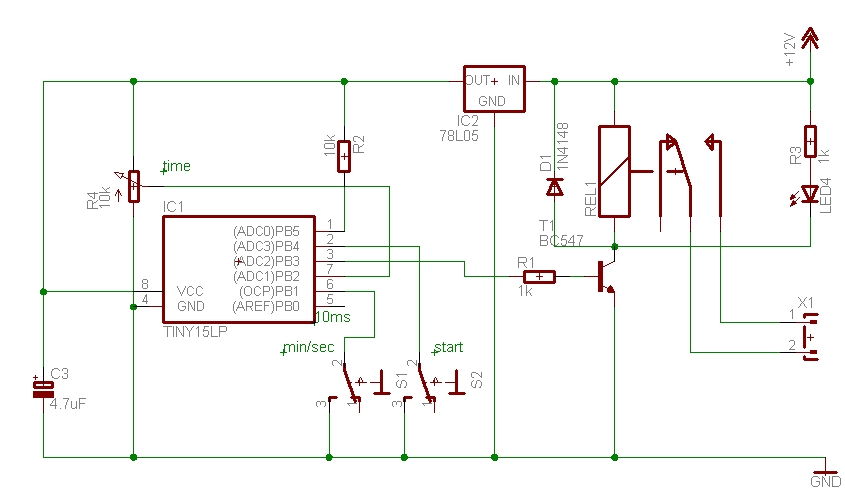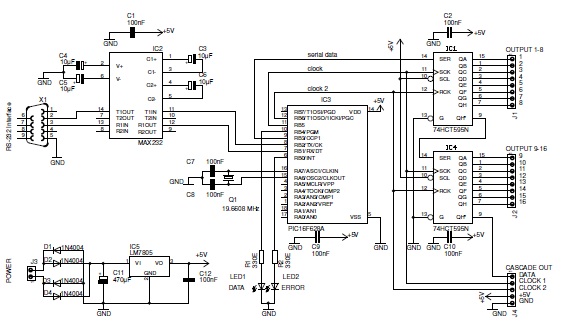
Timer circuit

The time can be set using a potentiometer ranging from 1 minute to 1023 minutes, approximately 17 hours. A pushbutton initiates the timing process, activates a relay, and the timer will deactivate the relay once the set time has elapsed. The timer can also be switched to seconds for shorter periods (up to 17 minutes), which is useful for tasks like boiling eggs, where timing is critical. The ATTiny15 microcontroller utilizes an internal oscillator and requires calibration for a 10 ms high pulse on PB1. This calibration involves writing an appropriate value to the OSCCAL register, starting with OSCCAL_val = 0x6F. Achieving the correct 10 ms pulse length may require some trial and error. While the overall timing may not be extremely precise due to the absence of a quartz crystal, it is generally acceptable for applications such as battery charging, where slight variations in time are permissible. The potentiometer allows for quick and straightforward time adjustments. If a longer duration than 17 hours is needed, the value of cnt_cmp can be modified from 100 (which corresponds to 1 second) to a higher number, such as 200, effectively extending the timing capability to 34 hours. The timing can also be adjusted for shorter intervals by changing cnt_cmp accordingly. A high-to-low transition on PB4 will initiate the timer, allowing for the connection of devices like a light-dependent resistor (LDR) to PB4, which can function as a light switch that activates for the preset duration when it is dark. The timer will deactivate even if PB4 remains low, waiting for the switch or LDR to return to a high state, thus preventing false triggers during short timing intervals when the button is still pressed. This design offers flexibility and can be adapted for various applications requiring a timer.
The described circuit employs an ATTiny15 microcontroller as the core component, utilizing its internal oscillator for timing control. The user can set the desired time duration using a potentiometer, which adjusts a variable resistor in the circuit, influencing the time constant. The potentiometer's resistance value is converted into a digital signal that the microcontroller interprets to determine the timing period.
The pushbutton switch serves as the user interface for initiating the timing sequence. Upon pressing the button, the microcontroller activates a relay, which could control an external load, such as a lamp or other devices. The relay remains energized for the duration specified by the user, and the microcontroller monitors the elapsed time. Once the pre-set time expires, the microcontroller sends a signal to deactivate the relay, effectively turning off the connected device.
Calibration of the internal oscillator is critical for achieving accurate timing. The OSCCAL register is adjusted to ensure that the microcontroller generates a precise 10 ms pulse width. This calibration process may involve several iterations to account for variations in the oscillator's frequency due to environmental factors or manufacturing tolerances.
The capability to switch the timer to seconds for shorter durations enhances the circuit's versatility, making it suitable for tasks requiring precise timing, such as cooking or charging batteries. The adjustment of cnt_cmp allows for easy modification of the timing range, accommodating various application needs.
The inclusion of PB4 for initiating the timer adds further functionality. This pin can be connected to various sensors, such as an LDR, enabling the circuit to operate based on environmental conditions. The design prevents false triggers by ensuring that the timer can only be reset by a high signal on PB4 after the timer has completed its cycle, thus enhancing reliability in practical applications.
Overall, this circuit design provides a robust and flexible solution for timing applications, with user-friendly adjustments and reliable operation based on the ATTiny15 microcontroller's capabilities.The time can be set with a potentiometer between 1 minute and 1023 minutes, about 17 hours. A pushbutton starts the time, turns on a relais and the timer will turn off the relais when the time is elapsed. It can be switched to seconds for a shorter time period (17 minutes) e. g. to boil eggs, also easy to forget about. The ATTiny15 is using an inte rnal oscillator only and needs a calibration for a 10 ms high pulse on PB1, so it is necessary to write a good calibration byte to the OSCCAL register, which is in the beginning of the program OSCCAL_val= 0x6F. It`s a bit of trial and error until the 10 ms are set for your contoller but is should be done. The total time is not extremely accurate because we can`t use a quartz, but for a battery charger I think it is good enough, the batteries don`t mind a few minutes more or less.
However, time setting with a potentiometer is quick and easy. If 17 hours are not sufficient and a longer time is required it is possible to change the value of cnt_cmp = 100 ; 100 * 10 ms = 1 second in the program to e. g. cnt_cmp = 200, which will double the time to 34 hours. Depending on your application the time can also be much shorter, change cnt_cmp accordingly. Any high to low transition on PB4 will start the timer, even a LDR could be connected to PB4 to make a light switch which turns on for the preset time when it is dark.
It will turn off even if PB4 is still low and then waits for the switch or LDR to go high again. This also prevents a false trigger when the time is short and the button is still pressed. It is quite flexible and can be adapted to many applications which need a timer. 🔗 External reference
The described circuit employs an ATTiny15 microcontroller as the core component, utilizing its internal oscillator for timing control. The user can set the desired time duration using a potentiometer, which adjusts a variable resistor in the circuit, influencing the time constant. The potentiometer's resistance value is converted into a digital signal that the microcontroller interprets to determine the timing period.
The pushbutton switch serves as the user interface for initiating the timing sequence. Upon pressing the button, the microcontroller activates a relay, which could control an external load, such as a lamp or other devices. The relay remains energized for the duration specified by the user, and the microcontroller monitors the elapsed time. Once the pre-set time expires, the microcontroller sends a signal to deactivate the relay, effectively turning off the connected device.
Calibration of the internal oscillator is critical for achieving accurate timing. The OSCCAL register is adjusted to ensure that the microcontroller generates a precise 10 ms pulse width. This calibration process may involve several iterations to account for variations in the oscillator's frequency due to environmental factors or manufacturing tolerances.
The capability to switch the timer to seconds for shorter durations enhances the circuit's versatility, making it suitable for tasks requiring precise timing, such as cooking or charging batteries. The adjustment of cnt_cmp allows for easy modification of the timing range, accommodating various application needs.
The inclusion of PB4 for initiating the timer adds further functionality. This pin can be connected to various sensors, such as an LDR, enabling the circuit to operate based on environmental conditions. The design prevents false triggers by ensuring that the timer can only be reset by a high signal on PB4 after the timer has completed its cycle, thus enhancing reliability in practical applications.
Overall, this circuit design provides a robust and flexible solution for timing applications, with user-friendly adjustments and reliable operation based on the ATTiny15 microcontroller's capabilities.The time can be set with a potentiometer between 1 minute and 1023 minutes, about 17 hours. A pushbutton starts the time, turns on a relais and the timer will turn off the relais when the time is elapsed. It can be switched to seconds for a shorter time period (17 minutes) e. g. to boil eggs, also easy to forget about. The ATTiny15 is using an inte rnal oscillator only and needs a calibration for a 10 ms high pulse on PB1, so it is necessary to write a good calibration byte to the OSCCAL register, which is in the beginning of the program OSCCAL_val= 0x6F. It`s a bit of trial and error until the 10 ms are set for your contoller but is should be done. The total time is not extremely accurate because we can`t use a quartz, but for a battery charger I think it is good enough, the batteries don`t mind a few minutes more or less.
However, time setting with a potentiometer is quick and easy. If 17 hours are not sufficient and a longer time is required it is possible to change the value of cnt_cmp = 100 ; 100 * 10 ms = 1 second in the program to e. g. cnt_cmp = 200, which will double the time to 34 hours. Depending on your application the time can also be much shorter, change cnt_cmp accordingly. Any high to low transition on PB4 will start the timer, even a LDR could be connected to PB4 to make a light switch which turns on for the preset time when it is dark.
It will turn off even if PB4 is still low and then waits for the switch or LDR to go high again. This also prevents a false trigger when the time is short and the button is still pressed. It is quite flexible and can be adapted to many applications which need a timer. 🔗 External reference





